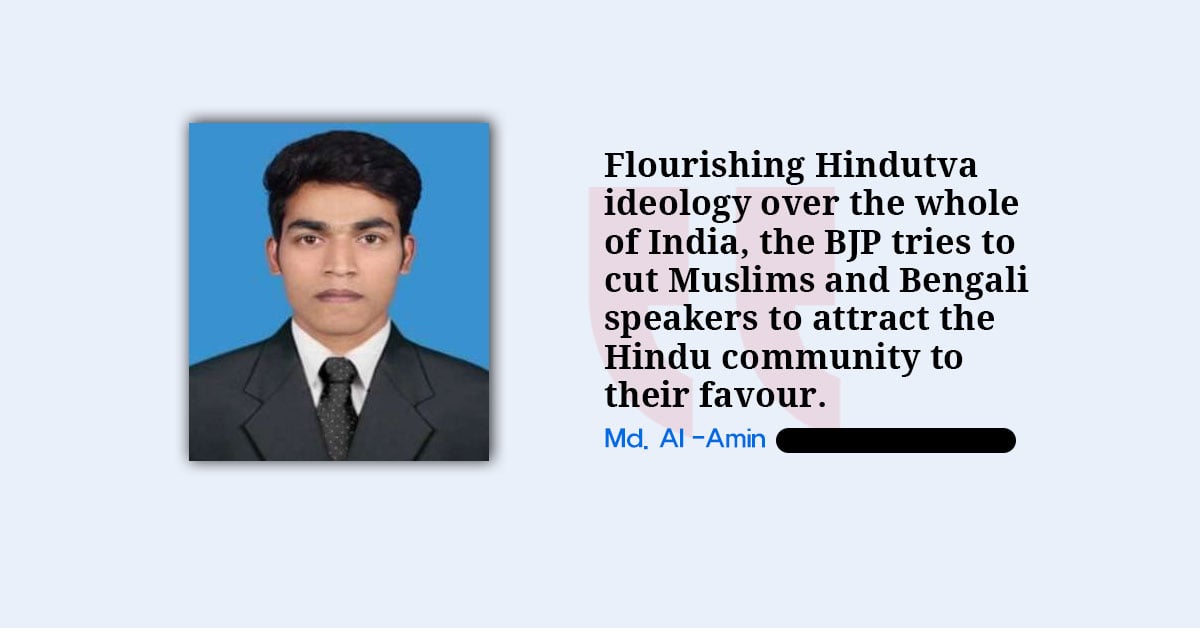

India is frequently regarded as the world’s largest democracy, characterised by significant linguistic, religious, and cultural variety unified by a collective dedication to pluralism and constitutional principles. But the way they react to some internal issues and the internal issues of neighbouring countries constructs different scenarios. Among the 22 scheduled languages recognized in the Indian Constitution, Bengali has the second largest native speakers in India, not only in West Bengal and Tripura but also by significant populations in Assam, Jharkhand, Odisha, and other states.
Citing official figures, Mamata Banerjee, the Chief Minister of West Bengal, noted that over 22 lakh migrant workers from West Bengal are currently employed across various parts of India, and that they hold valid identity documentation.
Recently, those legal Bengali-speaking people have been detained and marked as illegal intruders who are working as migrant workers in different states of India. Presumably, the central government of India particularly exerted political domination over West Bengal’s largest political party, “Trinamool Congress”. The Bharatiya Janata Party (BJP) led Modi government is much more aggressive than before to assert its power in its court. Regarding political supremacy, they have used their biggest trump card “Hindu-Muslim” dichotomy, over the years.
Last few years, they have always put their political agenda through fragmenting hindu-muslim issues, issuing a new Citizenship Amendment Act (CAA) in 2019; the National Register of Citizens (NRC) in Assam, by which tension has always persisted in the targeted community. Simultaneously, once again, they have come up with a new political ploy targeting West Bengal.
Only through the symbols of speaking in the Bengali language, the BJP-led government declared them as illegal Bangladeshi or Rohingya refugees. West Bengal’s chief minister also aimed the alleged narrative linking Bengali migrants to illegal immigration, challenging the BJP to substantiate its claims: “I challenge you to prove that Bengali-speaking migrants are Rohingya Muslims.”
Again, certainly that is not politically correct as well. If that is so, I will have to flee from West Bengal to Bangladesh as I also speak in Bengali language, quoted by Nobel laureate Amartya Sen earlier this week. These two statements clearly uphold the evidence of the BJP’s atrocities.
Between May 7 and August 15, 2025, over 1,900 Bengali-speaking Muslims (mostly women and men) were illegally expelled into Bangladesh by Indian authorities without legal procedure. Authorities in Uttar Pradesh, Odisha, Gujarat, Maharashtra, Haryana, and Delhi – all states ruled by Mr Modi’s BJP party – rounded up mostly Bengali-speaking migrant workers from West Bengal and Assam. Earlier, the BJP-led Indian central government addressed some epoch-making laws that most of it has gone against muslim minorities, Bengali-speaking people as marking them illegal Bangladeshis. In the year of 2019, the central government of India first introduced NRC. The NRC is a registry meant to identify legal Indian citizens and weed out “illegal immigrants,” particularly from neighboring Bangladesh. In Assam, the NRC was updated to include only those who could prove their or their ancestors’ presence in India before March 24, 1971.
The NRC disproportionately eliminated Muslims and Hindus who spoke Bengali, even people who had lived in Assam for many generations. A significant number of the 1.9 million individuals who were left off the final 2019 Assam NRC list were Muslims who spoke Bengali. Many Bengali speakers, particularly those living in underprivileged or rural areas, were excluded because they lacked official documentation or had misspellings or names.
The CAA offers non-Muslim immigrants from Pakistan, Bangladesh, and Afghanistan who arrived in India on or before December 31, 2014, as a result of religious persecution, a streamlined path to Indian citizenship. Even after decades of residency in India, Muslims who speak Bengali are not granted any relief under the CAA. If excluded from the NRC, individuals run the risk of being classified as “illegal immigrants” who lack a legitimate route to citizenship. The CAA shields non-Muslim Bengali speakers—Hindus in particular—from the consequences of the NRC. Muslims who speak Bengali are at the most danger of being persecuted by the law and becoming stateless.
The government of Narendra Modi targets Bengali-speaking Muslims from West Bengal and Assam for political gain ahead of elections in the two eastern states. Mr Modi this month accused Ms Banerjee’s government in West Bengal of “encouraging” illegal immigration for the sake of vote bank politics”.
The issue of immigration from Bangladesh is expected to become a focal point of the 2026 election in West Bengal, a key target for the BJP.
Flourishing Hindutva ideology over the whole of India, the BJP tries to cut Muslims and Bengali speakers to attract the Hindu community to their favour. But this also reflects their chauvinism profoundly. In this regard, the West Bengal government and civil society launched political, legal, and social protests in response to these instances, and the Calcutta High Court made robust statements.
Mamata Banerjee led a large-scale protest rally in Kolkata on July 16, 2025, from Hazra to Dharmatala, denouncing the use of the term “Bangladeshi” to refer to Bengali speakers in some regions of India. Calling this an assault on Bengali identity and dignity, the Trinamool Congress (TMC) held public gatherings and protests throughout the state. This inclination became known as “linguistic terrorism” by Chief Minister Mamata, who claimed that Bengali speakers were being singled out due to their name or language.
Finally, I am Bengali, not Bangladeshi – stop playing around with my identity. That type of acute protest will be spread across West Bengal, which will turn BJP’s political strategy to TMC’s favor. So, this type of Cultural assault mixed with political motives may deteriorate the normal environment into a huge political upheaval all over the whole India, isn’t it very much possible?